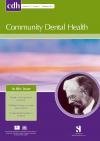Community Dental Health

- Cover Date:
- December 2012
- Print ISSN:
- 0265 539X
- Vol:
- 29
- Issue:
- 4
Cost-effectiveness models for dental caries prevention programmes among Chilean schoolchildren
Aim: This study aims to estimate the cost-effectiveness from a societal perspective of seven dental caries prevention programmes among schoolchildren in Chile: three community-based programmes: water-fluoridation, salt-fluoridation and dental sealants; and four school-based programmes: milk-fluoridation; fluoridated mouthrinses (FMR); APF-Gel, and supervised toothbrushing with fluoride toothpaste. Methods: Standard cost-effectiveness analysis methods were used. The costs associated with implementing and operating each programme, using a societal perspective, were identified and estimated. The comparator was non-intervention. Health outcomes were measured as dental caries averted over a 6-year period. Costs were estimated as direct treatment costs, programmes costs and costs of productivity losses as a result of each dental caries prevention programme. Incremental cost-effectiveness ratios were calculated for each programme. Sensitivity analyses were conducted over key parameters. Results: Primary cost-effectiveness analysis (discounted) indicated that four programmes showed net social savings by the DMFT averted. These savings encompassed a range of values per diseased tooth averted; US$16.21 (salt-fluoridation), US$14.89 (community water fluoridation); US$14.78 (milk fluoridation); and US$8.63 (FMR). Individual programmes using an APF-Gel application, dental sealants, and supervised tooth brushing using fluoridated toothpaste, represent costs for the society per diseased tooth averted of US$21.30, US$11.56 and US$8.55, respectively. Conclusion: Based on cost required to prevent one carious tooth among schoolchildren, salt fluoridation was the most cost-effective, with APF-Gel ranking as least cost-effective. Findings confirm that most community/school-based dental caries interventions are cost-effective uses of society’s financial resources. The models used are conservative and likely to underestimate the real benefits of each intervention. K
Key words: Fluoride, cost-effectiveness, dental caries prevention, Chile
- Article Price
- £15.00
- Institution Article Price
- £
- Page Start
- 302
- Page End
- 308
- Authors
- R. Mariño, J. Fajardo, M. Morgan
Articles from this issue
- Title
- Pg. Start
- Pg. End
- Recent trends in incidence and mortality of oral and pharyngeal cancer in Schleswig-Holstein in Northern Germany
- 268
- 273
- Children’s views on the experience of a visual examination and intra-oral photographs to detect dental caries in epidemiological studies
- 284
- 288
- Cost-effectiveness models for dental caries prevention programmes among Chilean schoolchildren
- 302
- 308
